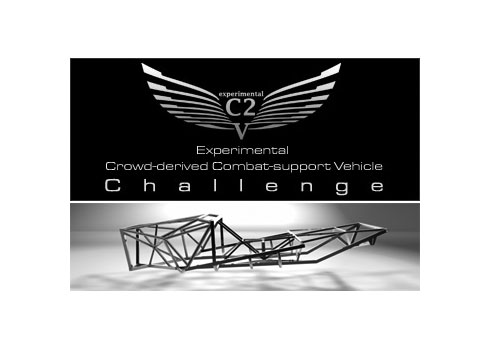The Department of Defense’s agency in charge of advanced research and design is looking for new designers to work on the next generation of military vehicles. But the DoD is not directly recruiting from MIT, Carnegie Mellon or the nations’ other top computer science and engineering schools. Instead they’re looking to you, America, to help with the next generation of military design.
Last week, The Defense Advanced Research Projects Agency (DARPA) announced a competition to help design an experimental combat-support vehicle. DARPA is looking for a design for a four-wheeled vehicle that can either transport four passengers or three passengers laying-down for evacuations.
According to the contest’s home page, the vehicle is intended to be light and highly mobile. “Visibility is key: This vehicle should have the ability to have visibility like a control tower,” the guidelines read. In addition to having built-in places for defending the vehicle, the V8 vehicle will have to carry up to five passengers or three passengers plus their gear.
The contest runs until March 3, 2011. First prize is $7,500. Second and third prizes are $1,500 and $1,000. Designers must include images of their concepts from a number of perspectives.
“The XC2V challenge is intended to explore the issues raised by using a crowd-sourcing approach to the development of a militarily relevant vehicle,” Lt. Col. Nathan Wiedenman, a DARPA deputy program manager told TPM. “By capturing the lessons learned from this experience, DARPA can better shape future efforts that are focused on democratizing design through crowd-sourcing and collaborative online development.”
DARPA’s press release stated in their press release that they hoped the crowd-sourcing experiment would help gauge the how feasible it is to streamline military vehicle design through crowd-sourcing. “Would [today’s warfighters’] ability to face rapidly changing mission demands improve by introducing a dynamic method of manufacturing military vehicles,” the press release asks.
This dynamic system would greatly benefit such a large organization like DARPA and the entire Department of Defense. “Our current defense development paradigm requires that designers work for large corporations with the capital needed to physically build vehicle prototypes. Crowd-sourcing democratizes that design process,” Wiedenman said.
DARPA hopes this democratization will help to improve how quickly it can bring new designs from conception to operation. “By leveraging the power of the crowd, we can contribute to reducing that timeline significantly,” DARPA’s statement read. In addition to reducing time, DARPA hopes that the contest will include novel design ideas that its designers have not yet considered.
But as a Wired Magazine Danger Room blog post noted, this is not DARPA’s first foray into out-sourcing its research and design. In 2007, a Carnegie Mellon team won the $2 million Urban Challenge by creating an autonomously driven car that could navigate urban traffic.
DARPA sponsored a similar competition for autonomous battlefield vehicles. A Stanford University Team won that competition. And in 2009, an MIT team won DARPA’s Network Challenge when they located ten randomly placed markers in the United States using social media and the Internet.
The current contest is being facilitated by Local Motors, Inc, a company dedicated to building crowd-sourced cars. Their first production car, the Rally Fighter, was officially released in June 2009. Since then, the company has sold over one hundred, $59,000 Rally Fighters.
Here is the full text of DARPA’s Press Release:
Win up to $10,000, Support the Warfighter
DARPA issues Experimental Crowd-derived Combat-support Vehicle (XC2V) Design ChallengeToday’s warfighters are called upon to operate at peak efficiency in virtually every terrain and under myriad harsh environmental conditions. Would their ability to face rapidly changing mission demands improve by introducing a dynamic method of manafucturing military vehicles that streamlines the design/build process, introduces the latest in innovation, and keeps pace with the needs of the warfighter?
From concept to construction current military vehicle manufacturing processes take several years. By leveraging the power of the crowd, we can contribute to reducing that timeline significantly. Additionally, this opens the aperature to introduce greater ideas and design compilation with a reduction in time and the potential for a better performing vehicle. This more efficient process could save lives and improve mission success.
The Defense Advanced Research Projects Agency (DARPA) seeks to engage the crowd for its latest challenge. The Experimental Crowd-derived Combat-support Vehicle (XC2V) Design Challenge, facilitated by Local Motors, Inc. asks individuals to conceptualize a vehicle body design for two different missions–Combat Reconnaissance and Combat Delivery & Evacuation.
This is an opportunity for servicemembers, race and auto enthusiasts, and those with an interest and talent in engineering, materials, industrial design, etc., to support the warfigther by contributing to the future of military vehicle manufacturing, win up to $10,000, and see their design become a reality in the form of a fully functioning concept vehicle.
This competition provides experts, novices and the curious the opportunity to provide input to the final design of the vehicle. Whether you provide a design or just vote on the best submission, you can contribute.
The challenge begins today, and final submissions are due March 3, 2011.
Visit the XC2V challenge webpage at http://www.local-motors.com/XC2V for complete challenge details, to register, and join the Xcitement.Spread the word and stay informed by following the XC2V challenge on Facebook and Twitter.
(http://www.facebook.com/DARPA) and Twitter (http://twitter.com/darpa_news).






